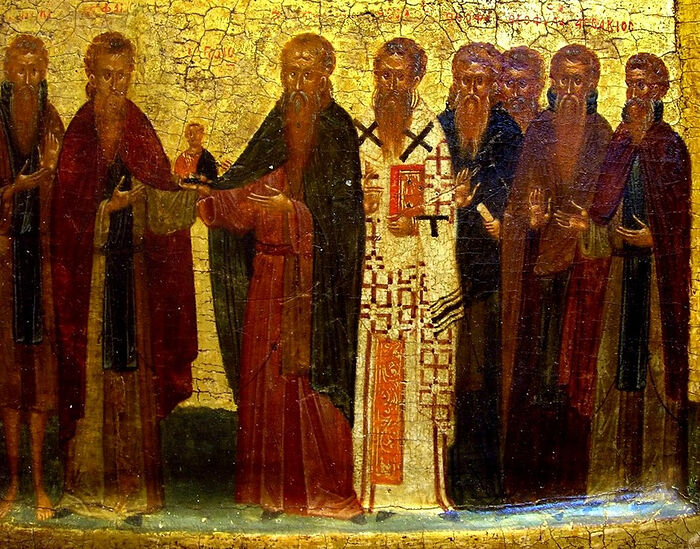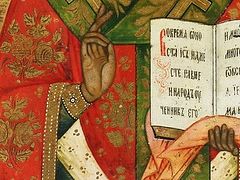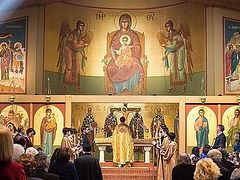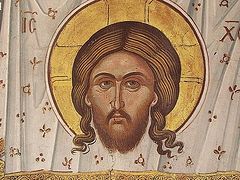 The Triumph of Orthodoxy. Byzantine icon, 15th c.
The Triumph of Orthodoxy. Byzantine icon, 15th c.
Brethren, already we are at the first harbor of Great Lent, the Sunday of Orthodoxy. The Church stops here after one week of fasting and ascetic struggles for piety’s sake to celebrate an important victory: the Triumph of the Orthodox Faith. This occurred in the eighth and ninth centuries when a terrible heresy overtook the Church and shattered the peace of Christians. This heresy was called Iconoclasm and those who followed it were called Iconoclasts, that is, “those who break or destroy icons.”
There is a specific historical narrative to the events surrounding the Seventh Ecumenical Council, wherein the veneration of icons was restored after ninety or so years of persecution, which occurred in two periods: between 726 and 787, and between 814 and 842. In the year 787 the Seventh Ecumenical Council occurred wherein Iconoclasm was condemned and Orthodoxy was restored. However, by 814, Iconoclasm had returned within the Byzantine Empire due to the socio-political events of the time. The veneration of the holy icons was restored on the First Sunday of Great Lent in the year 843 once and for all by Empress Theodora; until that time the Church commemorated the holy prophets on that Sunday as is evidenced by the verses after the epistle at the Liturgy. From 843 until our own days the First Sunday of Lent is dedicated to the triumph of the Orthodox Faith not only over the Iconoclastic heresy, but over every heresy which occurred through the sum-total of the Church’s history.
The holy icons are evidence of the intimate connection between our world and the immaterial, noetic world. They are evidence that the Son of the Father became man for our sake. They are witnesses to Christ’s Incarnation and to the witness of Orthodoxy. They are a confirmation of the mystery of piety, the mystery of Faith which is reflected in the Synodikón of the Seventh Ecumenical Council. This mystery is affirmed by the Holy Apostle Paul to Timothy, wherein he captures the essence of the Incarnation: Great is the mystery of piety: God was manifest in the flesh, justified in the Spirit, seen of angels, preached unto the Gentiles, believed on in the world, received up into glory.
If God joined Himself to our material reality in the Incarnation and deified it, then what stops Him from working by and through objects connected to this material reality, such as paint and wood? St. John of Damascus, perhaps the most prominent venerator and defender of the holy icons, taught: When He Who is a pure spirit, immeasurable in the boundlessness of his own nature, existing as God, takes on the form of a servant and a body of flesh, then you may draw His likeness, and show it to anyone who is willing to contemplate it. Depict His coming down, His virgin birth, His Baptism in the Jordan, His Transfiguration on Mt Tabor, His all-powerful sufferings, His death and miracles, the proofs of His deity, the deeds He performed in the flesh through Divine power, His saving Cross, His grave, His Resurrection and His ascent into Heaven. Give to it all the endurance of engraving and color.
Therefore, the holy icons bear witness to the Incarnation of the Word and to the sanctification of matter. The holy icons bear witness to the restoration of the world which is now sanctified and re-dedicated to God; the Heavenly realities are now reflected by earthly principles and the boundaries of division are torn asunder, assuring us of the future Resurrection of mankind to glory and life and immortality: Icons are testaments to the Resurrection, visual reminders to us that Christ walked in our midst having assumed our nature, and that those who live His life as exemplified in the Holy Gospel—those who did receive Him—have an inheritance inviolable and incomprehensible by human standards and logic; they are—as we will hear on Pascha night—those to whom He has granted a Divine prerogative: to be called His children. To all who did receive Him, to those who believed in His name, He gave the right to become children of God—children born not of blood, nor of the desire or will of man, but born of God. And the Divine Theologian continues to state the premise behind our logic in venerating the holy icons: The Word became flesh and made His dwelling among us. We have seen His glory, the glory of the one and only Son from the Father, full of grace and truth.
And if Christ sanctified and redeemed the material world by the Incarnation, and thus inanimate objects such as wood and paint can be used to connect our reality with the ethereal world, and if gold and silver which are also devoid of life can be used to hold Christ’s Body and Precious Blood in the Liturgy, then does logic not follow that each man and woman born into the world is an icon of the Living God, an icon fashioned in His image and likeness, for whom He endured the Passion and the Crucifixion? Did He not arise triumphantly from the grave, thus encoding, as it were, the Resurrection upon our human nature, condemning us not to death but to immortality in the Resurrection (to paraphrase St. Justin of Celije)? We are called to transform our interior icon, the interior man, into an abode of the Holy Spirit. We accomplish this through the Church which Christ established, the Orthodox Church, which is the guardian of Orthodoxy and the Holy Tradition, the Sacramental life, within which Christ’s life is made manifest. It is here that the words, He was believed on in the world, take essence and meaning and depth, in the Holy Sacraments of Baptism and Chrismation wherein the fallen icon is cleansed and raised to the former glory, and in Holy Confession and Holy Communion wherein the icon receives renewed color and energy and is continuously restored, healed, and sanctified each time the faithful partake in the fear of God, with faith and love.
The saints depicted in iconography are so depicted because they too reflect Christ, the Image of the Father perfectly. They are depicted in immaterial icons having become themselves living icons and living gospels. The saints live the mystery of piety, the mystery of the Orthodox Faith. According to St. Ignaty Brianchaninov, Orthodoxy is defined as: The true knowledge of God and reverence of God. Orthodoxy is the worship of God in Spirit and in Truth. Orthodoxy is the glorification of the true God, the knowledge of Him and worship of Him. Orthodoxy is the glorification of God by man, the true servant of God, given to him through the grace of the Holy Spirit. The Spirit is the glory of the Christian (cf. Jn 7:39). Where there is no Spirit, there is no Orthodoxy. The saints possess this true knowledge by their participation in the Church’s Sacramental life with the proper pre-conditions, namely, a cleansed and repentant heart. Perhaps it is more precise to say that the saints are the natural results of the Church’s Sacramental life, wherein God is worshiped in Spirit and Truth, with all knowledge and diligence and all proper decorum.
On this day, magnificent processions are held with the holy icons and this journey of the Church—through Great Lent—is iconified before our eyes. At the end of the procession, the Synodikon, or the final act of the Seventh Ecumenical Council is proclaimed in an abridged fashion: Those who fought for Orthodoxy throughout history are lauded, and those who opposed the Orthodox Faith throughout history are condemned. Let us not forget the struggles of our Fathers for each particular dogma or tradition of the Faith. Let us not forget that each iota of the law is important; and how much more so are the details of ecclesiastical life : The external beauty leads to an interior mystery, and so we should be diligent to glorify God in an Orthodox manner, through a love of the Divine services and a maintenance and an invigoration of our precious liturgical traditions which all iconify the piety and love of our forefathers for the Orthodox Faith.
When we take up the holy icons to process on this day, let us not forget the blood poured forth for the preservation of their veneration, for the preservation and transmittance of Orthodoxy from that generation to our own. When everything is united within us and in our parishes—that is, when we approach the worship of the Church in the proper repentant and attentive interior disposition, coupled with our external, formal worship which we strive to execute correctly and piously, and our beautification of God’s house by which we are glorified in return by Divine power—then within us the Heavenly and earthly Liturgy will simultaneously occur and Orthodoxy will continuously triumph, defeating and subduing all enemies, visible and invisible. To Him Who is able to preserve the Church in the face of all persecution and opposition and pernicious heresy, and who is able to raise living icons to Himself, as children raised from dead rocks—to Christ our God be glory, power, dominion, and majesty unto the ages of ages. Amen!



